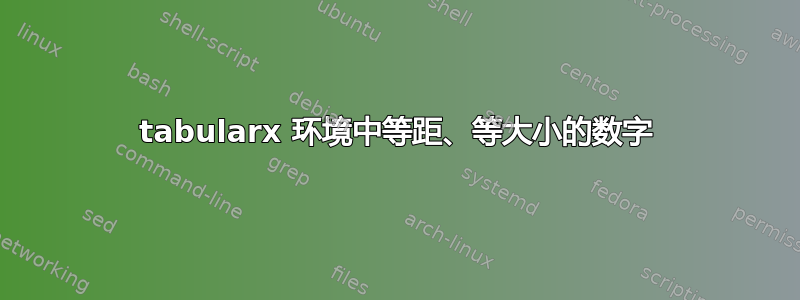
目前我通过 来实现4个不同图形的相同尺寸\includegraphics[width=0.197\linewidth]{example-image-a}。
但是,它0.197是硬编码的,因此不够优雅。
还有更多吗动态的实现期望输出的方法?
请参阅我的 MWE:
\documentclass[10pt, a4paper]{ltjbook}
\usepackage{luatexja}
\usepackage{CJKutf8}
\usepackage[left=1.9cm,right=1.9cm,bottom=1.5cm,top=1.5cm]{geometry}
\usepackage[table]{xcolor}
\usepackage{amsmath}
\usepackage{ruby}
\usepackage{tikz,pgfplots,makecell,array,aurical,longtable,booktabs,multicol,multirow}
\usetikzlibrary{patterns, mindmap, positioning, automata}
\usepackage{environ}
\usepackage{tabularx}
\usepackage{booktabs}
\usepackage{textcomp}
\usepackage{hhline}
\usepackage{textcomp}
\usepackage{wasysym}
\usepackage{multicol}
\usepackage{microtype}
\usepackage[table]{xcolor}
\usepackage{ulem}
\usepackage[none]{hyphenat}
\usepackage{xparse}
\usepackage{imakeidx}
\usepackage{setspace}
%>>>>>>>>>>>>>>>>>>>>>>>>>>>>>>>>>>>>>>>>>>>>>>>>>>>>>>>>>>>>
\newsavebox\ltmcbox
% The following command inhibits a column break after a group letter in the index
% It also swallows the following \\, because the \\ is here before the \nopagebreak.
\newcommand{\dontbreak}[1]{\\\nopagebreak} % Swallow the following \\
\makeindex[name=gen, columns=4, title={漢字 Index}, intoc, columnseprule, options=-s general.ist]
\newcommand{\gindex}[2]{\index[gen]{#1 & #2}}
%<<<<<<<<<<<<<<<<<<<<<<<<<<<<<<<<<<<<<<<<<<<<<<<<<<<<<<<<<<<<
%>>>>>>>>>>>>>>>>>>>>>>>>>>>>>>>>>>>>>>>>>>>>>>>>>>>>>>>>>>>>
\newcommand\strokesection{} % to make sure we can use this command
\def\strokesection#1\par#2\par{\vspace{5pt}\par
\parbox[t]{\linewidth}{{#1}\\#2\strut}\par
}
\makeatletter
\patchcmd\LT@array{\tabskip\z@}{\tabskip\fill}{\typeout{OK}}{\typeout{BAD}}
\setlength\LTleft{0pt}\setlength\LTright{0pt}
\makeatletter
\makeindex[name=stroke, columns=4, title={漢字 by Stroke Count}, intoc, columnseprule, options=-s strokes.ist]
\newcommand{\strokeshead}[1]{%
\rmfamily\textbf{#1 Stroke\ifnum#1>1 s\fi}%
}
\newcommand{\strindex}[2]{\index[stroke]{#1@\strokeshead{#1}!#2}}
%<<<<<<<<<<<<<<<<<<<<<<<<<<<<<<<<<<<<<<<<<<<<<<<<<<<<<<<<<<<<
\usepackage{hyperref}
\hypersetup{
colorlinks,
citecolor=black,
filecolor=black,
linkcolor=black,
urlcolor=black
}
\newcolumntype{A}{>{\centering\let\newline\\\arraybackslash}X}
\newcolumntype{B}{>{\raggedright\let\newline\\\arraybackslash}X}
\newcommand{\specialc}[2][c]{\setstretch{0.87}\begin{tabular}[#1]{@{}c@{}}#2\end{tabular}}
\newcommand{\speciall}[2][c]{\begin{tabular}[#1]{@{}l@{}}#2\end{tabular}}
\newcommand{\specialr}[2][c]{\begin{tabular}[#1]{@{}r@{}}#2\end{tabular}}
\usepackage{graphicx}
\pgfplotsset{compat=newest,compat/show suggested version=false}
\usetikzlibrary{pgfplots.groupplots,matrix,positioning,fit,calc,shapes,patterns,automata,plotmarks}
\setlength{\parindent}{0cm}
\renewcommand{\tabularxcolumn}[1]{>{\small}m{#1}}
\newcommand{\rye}[2]{\multicolumn{#1}{|l@{}|}{\renewcommand{\arraystretch}{1.2}\begin{tabularx}{0.95\columnwidth}{@{}B@{}}#2\end{tabularx}}\\\hline}
\usepackage{tocloft}
\newcommand{\listofkanji}{List of Kanji}
\newlistof{glyph}{lok}{\listofkanji}
\NewEnviron{glyph}[2]% environment name
{ \refstepcounter{glyph}%
\addcontentsline{lok}{glyph}{\protect\numberline{\theglyph}{\;}{\;}#1}
\begin{tabularx}{\columnwidth}{@{}|A|A|A|A|@{}}
\hhline{|----|}
\multicolumn{4}{|B|}{\cellcolor{black}{\color{white}\textbf{\large{漢字{\,}\theglyph{:}\;{#1}}}}} \\\hline %row comp
\hhline{|----|}
\multicolumn{1}{|c}{\includegraphics[width=0.197\linewidth]{example-image-a}} & \multicolumn{1}{|c}{\includegraphics[width=0.197\linewidth]{example-image-a}} &
\multicolumn{1}{|c}{\includegraphics[width=0.197\linewidth]{example-image-a}} &
\multicolumn{1}{|c|}{\includegraphics[width=0.197\linewidth]{example-image-a}}\\\hline
\multicolumn{4}{|B|}{\renewcommand{\arraystretch}{1.2}
\begin{tabularx}{0.95\columnwidth}{@{}B@{}}\BODY\end{tabularx}}\\\hline
\end{tabularx}\renewcommand{\arraystretch}{1}
}
\begin{document}
\begin{multicols}{2}
\begin{glyph}{Anew (更)}{anew}\label{glyph:anew}
The idea of \textit{doing things anew}, be it through \textsuperscript{[1]}\textit{revision}, \textsuperscript{[2]}\textit{reform} or \textsuperscript{[3]}\textit{renewal}, amongst others.\\\hline
A secondary meaning has to do with \textit{staying up late}, or \textit{the day growing late}.
\end{glyph}
\end{multicols}
\end{document}
答案1
添加了类似(更简单)的环境glyphx以消除烦人的 0.197。
仅相关的数据包被保留在前言中。
\documentclass[10pt, a4paper]{ltjbook}
\usepackage{luatexja}
\usepackage{CJKutf8}
\usepackage[left=1.9cm,right=1.9cm,bottom=1.5cm,top=1.5cm]{geometry}
\usepackage[table]{xcolor}
\usepackage{multicol}
\usepackage{environ}
\usepackage{tabularx}
\usepackage{hhline}
\usepackage{graphicx}
\newcolumntype{A}{>{\centering\let\newline\\\arraybackslash}X}
\newcolumntype{B}{>{\small\raggedright\let\newline\\\arraybackslash}X}
\setlength{\parindent}{0cm}
\renewcommand{\tabularxcolumn}[1]{>{\small\raggedright}m{#1}}
\usepackage{tocloft}
\newcommand{\listofkanji}{List of Kanji}
\newlistof{glyph}{lok}{\listofkanji}
\NewEnviron{glyph}[2]% environment name
{\refstepcounter{glyph}%
\addcontentsline{lok}{glyph}{\protect\numberline{\theglyph}{\;}{\;}#1}
\begin{tabularx}{\columnwidth}{@{}|A|A|A|A|@{}}
\hhline{|----|}
\multicolumn{4}{|B|}{\cellcolor{black}{\color{white}\textbf{\large{漢字{\,}\theglyph{:}\;{#1}}}}} \\\hline %row comp
\hhline{|----|}
\multicolumn{1}{|c}{\includegraphics[width=0.197\linewidth]{example-image-a}} & \multicolumn{1}{|c}{\includegraphics[width=0.197\linewidth]{example-image-a}} &
\multicolumn{1}{|c}{\includegraphics[width=0.197\linewidth]{example-image-a}} &
\multicolumn{1}{|c|}{\includegraphics[width=0.197\linewidth]{example-image-a}}\\\hline
\multicolumn{4}{|B|}{\renewcommand{\arraystretch}{1.2}
\begin{tabularx}{0.95\columnwidth}{@{}B@{}}\BODY\end{tabularx}}\\\hline
\end{tabularx}\renewcommand{\arraystretch}{1}
}
\NewEnviron{glyphx}[2]% added <<<<<<<<<<<<<<<<<<<<<
{ \refstepcounter{glyph}%
\addcontentsline{lok}{glyph}{\protect\numberline{\theglyph}{\;}{\;}#1}
\begin{tabularx}{\columnwidth}{|A|A|A|A|}
\multicolumn{4}{|l|}{\cellcolor{black}{\color{white}\textbf{\large{漢字{\,}\theglyph{:}\;{#1}}}}} \\\hline %row comp
\includegraphics[width=\linewidth]{example-image-a} &
\includegraphics[width=\linewidth]{example-image-a} &
\includegraphics[width=\linewidth]{example-image-a} &
\includegraphics[width=\linewidth]{example-image-a}\\\hline
\multicolumn{4}{|l|}{\renewcommand{\arraystretch}{1.2}
\begin{tabularx}{0.9\columnwidth}{@{}B@{}}\BODY\end{tabularx}}\\\hline
\end{tabularx}\renewcommand{\arraystretch}{1}
}
\begin{document}
\begin{multicols}{2}
\begin{glyph}{Anew (更)}{anew}\label{glyph:anew1}
The idea of \textit{doing things anew}, be it through \textsuperscript{[1]}\textit{revision}, \textsuperscript{[2]}\textit{reform} or \textsuperscript{[3]}\textit{renewal}, amongst others.\\\hline
A secondary meaning has to do with \textit{staying up late}, or \textit{the day growing late}.
\end{glyph}
\end{multicols}\bigskip
\begin{multicols}{2}
\begin{glyphx}{Anew (更)}{anew}\label{glyph:anew2}
The idea of \textit{doing things anew}, be it through \textsuperscript{[1]}\textit{revision}, \textsuperscript{[2]}\textit{reform} or \textsuperscript{[3]}\textit{renewal}, amongst others.\\ \hline
A secondary meaning has to do with \textit{staying up late}, or \textit{the day growing late.}
\end{glyphx}
\end{multicols}
\end{document}




